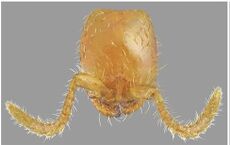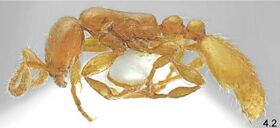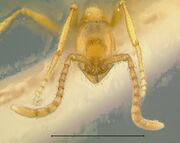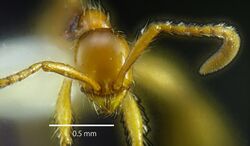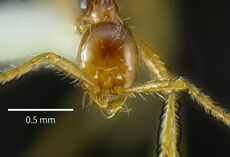Key to Aenictus wroughtonii group species
The following worker key is based on Jaitrong, W., Ruangsittichai, J. 2018. Two new species of the Aenictus wroughtonii species group (Hymenoptera, Formicidae, Dorylinae) from Thailand. ZooKeys, 775: 103-115 (doi: 10.3897/zookeys.775.26893).
Key to Asian species of the Aenictus wroughtonii species group based on worker caste.
You might be interested in
- Aenictus species groups (diagnoses)
- Key to Aenictus species groups
- The Aenictus genus page.
1
- Antennal scapes short, when laid back only attaining mid-length or two-thirds of the head length . . . . . 2
- Antennal scape long, when laid back attaining or extending beyond the posterolateral corner of the head . . . . . 4
2
return to couplet #1
- HW 0.31–0.33 mm; antennal scape attaining only mid-length of the head; petiole excluding subpetiolar process shorter than high (Thailand) . . . . . Aenictus samungi
- HW > 0.37 mm; antennal scape attaining two-thirds of the head length; petiole excluding subpetiolar process longer than high . . . . . 3
3
return to couplet #2
- Propodeal junction rounded; lateral faces of the petiole and postpetiole superficially reticulate; subpetiolar process present, its anteroventral corner angulate; postpetiole slightly longer than the petiole (Saudi Arabia) . . . . . Aenictus arabicus
- Propodeal junction angulate; lateral faces of the petiole and postpetiole entirely smooth and shiny; subpetiolar process convex dorsally, anteroventrally not angulate; postpetiole slightly shorter than the petiole (Thailand) . . . . . Aenictus nuchiti
4
return to couplet #1
- Propodeal junction rounded . . . . . 5
- Propodeal junction angulate . . . . . 9
5
return to couplet #4
- Subpetiolar process almost absent, anteroventrally not angulate (India) . . . . . Aenictus wroughtonii
- Subpetiolar process weakly developed; its anteroventral corner angulate . . . . . 6
6
return to couplet #5
- Entire pronotum and petiole sculptured (punctate or reticulate) (China) . . . . . Aenictus gutianshanensis
- Pronotum and petiole largely smooth and shiny . . . . . 7
7
return to couplet #6
- HW 1.00–1.04 mm (Aktaç et al. 2004, measurements of syntypes); posterior margin of head concave (Greece, Iran, Israel, Turkey) . . . . . Aenictus rhodiensis
- HW < 0.60 mm; posterior margin of head almost straight or convex . . . . . 8
8
return to couplet #7
- Scape short; SI 100 or less; body hairy; the longest pronotal hair 0.23–0.25 mm; subpetiolar process very low, with ventral outline almost straight (India, Nepal, Afghanistan) . . . . . Aenictus sagei
- Scape long; SI 130–140; body with sparse hairs; the longest pronotal hair approximately 0.15–0.18 mm; subpetiolar process with ventral outline slightly convex (China, Vietnam, Thailand) . . . . . Aenictus artipus
9
return to couplet #4
- Ventral outline of subpetiolar process convex, anteroventrally not angulate . . . . . 10
- Ventral outline of subpetiolar process convex or almost straight; its anteroventral corner angulate . . . . . 11
10
return to couplet #9
- Declivity of propodeum narrower, seen from back strongly tapering above; petiole longer than high (PI 84–86); body smaller with TL 2.6–2.7 mm; antenna longer with SI 122–135 (Thailand, Indonesia, Malaysia, Philippines) . . . . . Aenictus camposi
- Declivity of propodeum broader and more rounded above; petiole almost as long as high (PI 95–100); body larger with TL 3.1–3.2 mm; antenna shorter with SI 114–118 (Sri Lanka) . . . . . Aenictus biroi
11
return to couplet #9
- Ventral outline of subpetiolar process strongly convex in anterior half; mesonotum partly and propodeum almost entirely densely sculptured; pronotum clearly demarcated from mesonotum by a shallow transverse groove (Taiwan, Vietnam and Thailand) . . . . . Aenictus vieti
- Ventral outline of subpetiolar process almost straight; entire mesonotum and propodeum smooth and shiny, with at most superficial sculpture; pronotum only weakly demarcated from mesonotum (Thailand) . . . . . Aenictus stenocephalus










